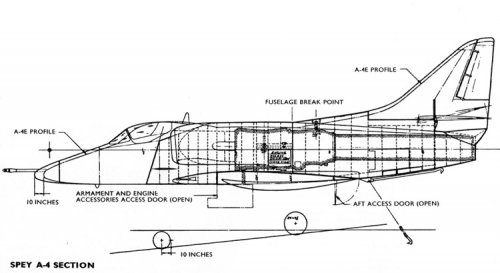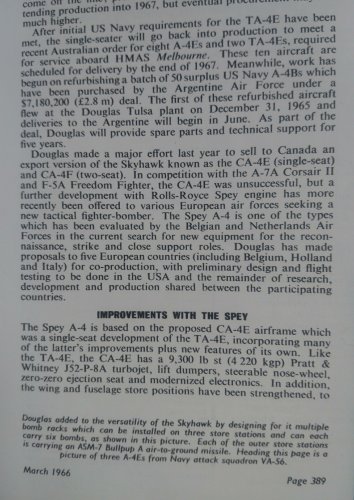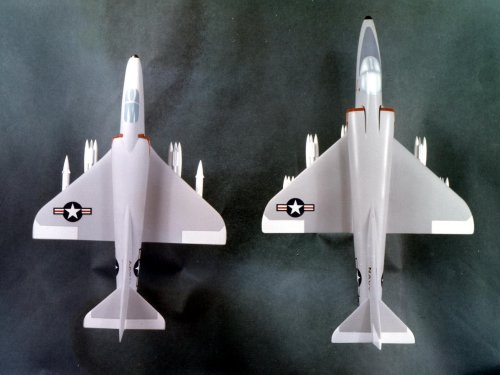- Joined
- 27 December 2005
- Messages
- 17,752
- Reaction score
- 26,434
IMPROVEMENTS WITH THE SPEY
The Spey A-4 is based on the proposed CA-4E airframe which was a single-seat development of the TA-4E, incorporating many of the latter's improvements plus new features of its own. Like the TA-4E, the CA-4E has a 9,300 lb st (4220 kgp) Pratt & Whitney J52-P-8A turbojet, lift dumpers, steerable nose-wheel, zero-zero ejection seat and modernized electronics. In addition. the wing and fuselage store positions have been strengthened, to permit maximum loads of 4,600 lb (2086 kg) on the fuselage, 2,600 Ib (1180 kg) on each inner wing position and 1,000 Ib (454 kg) loads on the outer pylons. The maximum weight is increased by 2,920 lb (1325 kg) to 27,420 lb (12440 kg), and low pressure tyres are introduced for operations from unprepared fields.
All these features are offered in the Spey A-4, but use of the Rolls-Royce turbofan offers 41 per cent more thrust and 17-24 per cent lower cruising sfc compared with the J52-P-6A in the standard Navy A-4E, with consequent performance improvement. The Spey version in the Skyhawk is the RB.168-20, rated at 12,000 lb st (5443 kgp) and specified also for the HS 801(maritime Comet); it is essentially an unreheated version of the RB. 168-25R specified for the F-4K Phantom II and is a military version of the RB.163-25 in the later Tridents and One-Elevens.
The Spey weighs some 470 lb (213 kg) more than the J52 and has a frame diameter 3.5 in (8.9 cm) greater. To accommodate this larger engine, the fuselage of the Skyhawk is deepened by 5 in (12.7 cm) aft of the self-sealing fuel tank behind the cockpit, and is lengthened by a 10 in (25.4 cm) section just aft of the cockpit. The engine air intakes are enlarged to match the greater air mass flow requirement, the minimum cross-section of the inlet duct being increased from 3.3 sq ft to 5 sq ft (0.31 to 0.46 m'). The changes to the fuselage involve a small increase in fin area by increasing the chord and the overall height of the fin.
Approximately one-third of the bare airframe (less engine) by weight is modified for the Spey installation. Materials and construction methods are unchanged, but the changes in the fuselage shape require some re-arrangement of the equipment in the centre and rear fuselage and some re-routing of control cables. Other items needing modification in the Spey installation include the cockpit environment control system (for compatibility with the higher pressures and temperatures of bleed air from the J52; the pneumatic system which pressurizes the fuel system; and the hydraulic system (because of larger-displacement, lower-speed pumps used on the Spey).
The Spey A-4 has an empty weight of 10,739 lb (4871 kg), compared with 9,853 lb (4470 kg) for the standard A-4E. As already noted, there is a 2,920 Ib (1325 kg) difference in maximum weights and the maximum ordnance load is increased to 12,000 lb (5443 kg). Key points of the Spey A-4's performance are its ability to take-off in 3,840 ft (1170 m) at max weight: its 2,750 naut mile (5 095 km) ferry range without refuelling and its Mach 0.92 max speed (590 knots-1093 km/h) at 35,000 ft (10670 m).
Douglas estimate that there is currently a market for about 2,000 low-cost ground attack aircraft, to replace F-84s, F-86s and other obsolescent aircraft. The competition for this market is growing, not only from other US manufacturers (primarily Northrop with the F-5A and Ling-Temco-Vought with the A-7A) but also from the European industry, primarily with the BAC/Breguet Jaguar (see Vol 21 No 6 p 371). At $764,000 (£272,000) complete with all-weather navigation equipment. the Spey A-4 is among the lowest priced of the available types, and is offered in quantity in less than two years from go-ahead.
Flying Review March 1966
Attachments
Last edited:



